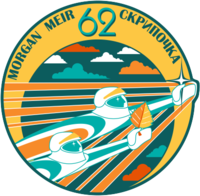Expedition 62
| Expedition 62 | |||
 | |||
| Uppdragsstatistik | |||
|---|---|---|---|
| Rymdstation: | ISS | ||
| Start: | 6 februari 2020 | ||
| Slut: | 17 april 2020 | ||
| Antal besättningsmedlemmar: | 6 st | ||
| Transport | |||
| Uppskjutning: | med Sojuz MS-13, Sojuz MS-15, Sojuz MS-16 | ||
| Uppskjutningsplats: | Kosmodromen i Bajkonur | ||
| Landning: | med | ||
| Landningsplats: | Kazakstan | ||
| Kronologi | |||
| |||
Expedition 62 är den 62:e expeditionen till Internationella rymdstationen (ISS). Expeditionen började den 6 februari 2020 då delar av Expedition 61s besättning återvände till jorden med Sojuz MS-13.
Anatolij Ivanisjin, Ivan Vagner och Christopher J. Cassidy anlände till stationen med Sojuz MS-16, den 9 april 2020.
Expeditionen avslutades den 17 april 2020 då Sojuz MS-15 lämnade rymdstationen.
Besättning
| Position | Första delen (6 februari - 9 april 2020) | Andra delen (9 april - 17 april 2020) |
|---|---|---|
| Befälhavare | Hans tredje rymdfärd | |
| Flygingenjör 1 | Hennes första rymdfärd | |
| Flygingenjör 2 | Hans första rymdfärd | |
| Flygingenjör 3 | Hans tredje rymdfärd | |
| Flygingenjör 4 | Hans första rymdfärd | |
| Flygingenjör 5 | Hans tredje rymdfärd | |
Externa länkar
| |||||||||||||||||||||
Media som används på denna webbplats
The official insignia of the Expedition 62 crew
- The Expedition 62 patch embodies two main themes: first, the importance of the global partnership on which the International Space Station was founded, and second, the paradigm shifting perspective provided by seeing our planet Earth from above with human eyes. Based on a vintage mosaic found near the headquarters of the Gagarin Cosmonaut Training Center, the two space explorers flying in formation represent friendship between space agencies and the people that work in them. The shining star in the hand is a symbol of unity under a common quest for discovery, as this partnership continues to burn bright into the future.
- Generated by the flying astronauts, the shock wave signifies the powerful impact of human space exploration and the scientific research conducted on the space station, strengthened when we work as a team, side by side with all of our international partners. The backdrop of the large sun behind our planet Earth reminds us that we are but a very small component of our solar system and our universe. The sun is also responsible for fueling life on Earth, sustaining the biosphere (symbolized by the leaf) surrounded by the precious, fragile atmosphere (represented by the clouds).
- This imagery reminds us of our duty to protect our home planet, to preserve our environment and to carry principles of responsible environmental stewardship with us as we explore the universe. This birch leaf combines the principal elements, embodying nature, science and the global alliance, as these trees are indigenous to regions that crewmembers from all sides call home.
The mission insignia for the Expedition 61 crew with Commander Luca Parmitano of ESA (European Space Agency), NASA astronauts Drew Morgan, Christina Koch and Jessica Meir and Roscosmos cosmonauts Alexander Skvortsov and Oleg Skripochka.
- The Expedition 61 patch represents an exciting and dynamic time aboard the International Space Station as it constantly advances towards a limitless future in space. The overall patch view is from an approaching vehicle in pursuit of the space station. The sun is the most prominent, central element in the patch as the source of energy and life for the Earth, the station and our entire solar system. As the present focus of human spaceflight, the space station is centered in the emblem while barely eclipsing the sun with its tiny shadow, reminding of us that human exploration is a small part of our quest to understand the universe.
- Fifteen of the sun’s rays represent the 15 original partner members of the space station program, while the 16th ray represents an open invitation for continued collaboration with new partners. The four yellow rays form the cardinal directions of a compass, symbolizing the innate human drive to explore. The advancing terminator represents the dawn of a new day on Earth. The name ring appears to float through space and has no single orientation, emphasizing the variety of viewpoints assembled in an international crew unified under one mission. Nine rays extend beyond the name ring to represent the nine human missions that have braved exploration beyond low-Earth orbit, thus encouraging us to drive boundlessly out into our solar system.
International Space Station (ISS) Expedition 63 mission insignia, incorporating a multitude of elements, such as a stylized 63 in the orbit traces, a boot print on the lunar surface.
- The Expedition 63 patch represents an intersection of the past and the beginning of a new dawn in human spaceflight as we continue to inhabit the International Space Station (ISS), aim towards returning to the moon and plan for the journey to Mars.
- Thirteen illuminated stars along the top of the patch commemorate the Apollo 13 celebrating its 50th anniversary during Expedition 63. The swoosh in the shape of the number "63" orbiting around the earth and moon honors the Apollo program and the future missions to go beyond low earth orbit.
- The atom, shown overlaid on a vibrant sunrise, is the Expedition 63 crew's call sign symbolizing the energy to revolve, or orbit around a nucleus or in their case, the Earth. The international crew depicts the importance of the collaboration in preserving the ISS as a microgravity and space environment research laboratory.






